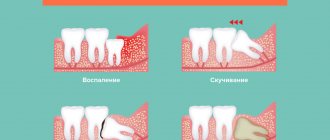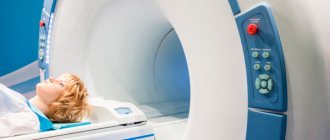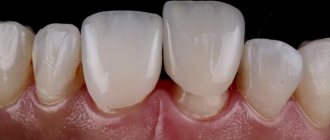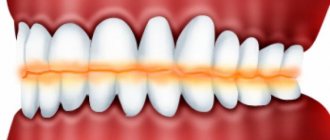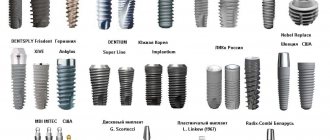An implant is a multicomponent system consisting of an intraosseous element and an abutment, an adapter between an artificial root and a prosthesis. The implant/abutment connection is precisely calibrated, without micro-gaps, with well-designed abutment positioning. These are important factors on which the correct distribution of the chewing load on the implant and the durability of the orthopedic system depend.
When a crown on an implant is loose, there is always a reason for it. If the implant itself remains motionless, most likely the fixing screw has been loosened or the crown has become uncemented (if it is cemented).
What to do? Go to an appointment with an orthopedist, who will determine the cause of the looseness and effectively solve the problem - replace the fixing component or reinstall the crown. The main thing is to accurately install a loose implant or crown. Indeed, in the first situation, reimplantation may be required, and the second option involves a simple adjustment of the coronal part; the implant itself does not need to be changed.
Symptoms
In the vast majority of cases, teeth become loose due to advanced caries and the presence of tartar. Clear signs that you will experience periodontal problems in the coming months:
- dark spots on tooth enamel;
- bleeding gums;
- high sensitivity of teeth to cold/hot;
- pain when chewing.
At the initial stage, the amplitude of tooth loosening does not exceed 1 mm. Subsequently, it increases, and the tooth wobbles in all directions. Biting or chewing with it is uncomfortable or even impossible.
Periodontal diseases are most often accompanied by atrophy of the jaw bone. That is, the volume of bone tissue in which the teeth are anchored gradually decreases. This is clearly noticeable by the “sagging” of the gum line, the formation of gum pockets and the increasing exposure of the necks of the teeth. If no measures are taken, bone volume can decrease catastrophically, leading to loose teeth. And this already threatens their loss.
How to solve a problem
If the crown is loose on a front or back tooth, do not try to remove it yourself. Only a specialist can do this correctly. After this, the doctor will carefully remove the cement and other elements of the system. After this, you will need to restore the shape of the stump or replace the stump tab. You will have to create a new single prosthesis and install it after all preliminary measures.
If the cause is a cyst
A cyst is a pathological neoplasm in the thickness of the gingival tissue, in the root region. As it grows and fills with purulent exudate, it provokes such unpleasant symptoms as pain with throbbing, inflammation and redness of the gums, the formation of a dense painful lump, increased body temperature and enlarged submandibular lymph nodes.
The photo shows a cyst above the crown
The appearance of a cyst after prosthetics is most often a consequence of the doctor’s negligence, neglect of the rules of asepsis and antisepsis. If you have aching, shooting pain, see a doctor immediately. You will have to take an x-ray to make an accurate diagnosis and prescribe appropriate treatment measures. Sometimes it is enough to remove the tumor surgically, possibly with resection of the root apex. In advanced cases, the tooth is completely removed and subsequent prosthetics are performed on an implant.
After removal of the cyst, the canals are re-treated within 7-10 days. In some cases, specialists prescribe antibiotics, treat the internal structures of the tooth with antiseptics, apply anti-inflammatory drugs and provide temporary prosthetics. Only after complete relief of the pathological process can a permanent prosthesis be installed.
Inflammatory process
If the denture is poorly fixed and a significant gap (more than 0.3 mm) remains between it and the gum, suitable conditions arise for the rapid proliferation of pathogenic microorganisms. Moreover, food debris will constantly get stuck in such a gap and plaque will accumulate. As a result, this will lead to redness and swelling of the adjacent gums - the development of an inflammatory process. Among its characteristic signs, experts identify the following symptoms:
- soreness,
- bleeding,
- severe swelling,
- increased reaction to mechanical and temperature stimuli,
- bad breath due to the addition of purulent processes.
Swelling and pus may form under the crown.
With such a clinical picture, urgent dental care is needed. First you need to find the source of inflammation and stop it. To do this, the doctor will remove the crown and carry out a comprehensive cleaning of the teeth from plaque and subgingival calculus. In the future, the patient will be prescribed antiseptic and anti-inflammatory drugs for self-administration: rinsing solutions (Stomatofit, Rotokan, Chlorophyllipt, Furacilin, etc.) and ointments (Solcoseryl, Cholisal, Asepta) etc.). Only after successful complex therapy will the doctor be able to perform repeated prosthetics.
If the crown falls out along with the implant
If the prosthesis has become mobile and it is installed on an implant, it is better to urgently see your attending surgeon. At any moment, the entire implant system can fall out and lead to other serious consequences, including inflammation of the jaw bone and the rapid development of osteomyelitis. If mobility and loss of the implant occurs due to the development of complications, for example, due to an inflammatory process, peri-implantitis or rejection of the structure, then you need to act very quickly.
The photo shows peri-implantitis
“When I placed my first implant, I encountered a complication. The tissue around the already installed rod became inflamed, and after about a month, that is, not immediately. I had to urgently remove everything and undergo quite a long treatment. I felt terrible then. Until now, no one has really explained to me what happened. I was given a new implant only six months later, and I had to pay the full amount for it again. A very bad experience, after that incident I changed clinics, but I forgot that one like a bad dream.”
Evgenia K., from correspondence on the 32top.ru forum
Usually the entire structure has to be removed, after which anti-inflammatory and antibacterial therapy is carried out. Perhaps, after stopping the pathological process, it will be necessary to perform osteoplasty - to replenish the atrophied areas of bone tissue. After such an operation, you need to wait from 3 to 6 months until the planted material has completely taken root. Only after this can we return to the issue of re-implantation.
Teeth started to loosen: what to do?
The sooner you go to the dentist, the greater the chance of saving the tooth. The doctor will suggest taking a targeted or panoramic X-ray, depending on how many teeth are loose. They can be used to determine the degree of periodontal damage and bone loss.
Before starting treatment, it is necessary to carry out professional oral hygiene - clean the teeth (including under the gums) from hard deposits (tartar) and bacterial plaque. This is a standard procedure performed with an ultrasound machine. Ideally, such cleaning should be carried out once every six months.
If necessary, the patient also undergoes systemic diagnostics and consults with specialized doctors. Further treatment depends on how loose the teeth are and what the causes of the loosening are.
Loosening of the implant
Sometimes the mobility of the crown results from a weakening of its connection with the artificial root. The dentist can determine during the examination that the implant is shaking, and not the prosthesis itself, and then the situation is assessed as more serious. The mobility of the artificial root is a symptom of its rejection. The reasons for this phenomenon:
- Ignoring the dentist’s recommendations for caring for implants, violating the rules for using new teeth.
- The patient's adherence to bad habits, such as smoking, frequent alcohol consumption.
- The patient develops a disease due to which the connection between the implant and the bone tissue is disrupted.
The fact of weakening of osteofixation (stability in the bone) of the artificial root under the crown is determined during diagnostic studies. After they are carried out, the doctor determines the possible cause of such a violation and draws up a treatment plan.
What will the doctor do if the tooth is loose?
In modern dentistry, tooth-preserving methods are practiced, so a tooth is removed only if it is very loose and cannot be restored. When an adult’s teeth become loose, treatment depends on the causes and course of the pathological process.
If the loosening is still minor and is caused by weakening of the gums, it is necessary to clean the periodontal pockets from bacterial deposits. For this purpose, therapy is carried out using the Vector device. The doctor directs a healing mixture into the pockets, which acts simultaneously with ultrasonic vibrations and effectively cleanses the teeth down to the roots. The procedure is painless and promotes gum healing. Also, many dentists use lasers for the same purposes.
After this, the doctor prescribes therapeutic treatment:
- applications with antiseptic drugs;
- applying medicinal gels to the gums that relieve inflammation and restore tissue;
- strengthening gums with rinses - herbal infusions (aloe, oak bark);
- taking vitamins;
- gum massage, which needs to be performed 3-4 times a day on your own;
- if there is inflammation with purulent discharge, the dentist will recommend antibiotics.
In severe cases of periodontitis, when the gum pockets are deep (more than 7 mm), surgical intervention may be necessary - open curettage. During this procedure, the surgeon opens the gum, clears the pocket of infection, applies medication, and sutures the tissue.
Why the bridge prosthesis is loose in the mouth - the reasons for mobility and how to deal with them
Why a bridge prosthesis is loose in the mouth - the reasons for mobility and how to deal with them We think it’s no secret that modern dentistry is moving forward with seven-mile strides along the path of various innovations. As we remember from previous articles, there are many options for replacing missing teeth. They are divided into two large groups: removable and non-removable dentures. Today we’ll talk about non-removable things, namely bridges. This method of prosthetics has been actively used by doctors for quite a long time, but is slowly fading into the background due to the development of implantation. But there are times when you can’t do without good old bridges. Let's figure out what a bridge is, what materials it is made from, and determine the main reasons for the instability of the structure. So what is a bridge?
This is a type of non-removable structure that has 2 supports in the form of artificial crowns, fixed to the teeth surrounding the defect, with an intermediate part to replace the missing chewing unit.
Bridges supported on teeth ground for crowns can be made of metal ceramics, metal-free ceramics (for example, zirconium dioxide and Emax glass ceramics). Several decades ago, prostheses made of steel and alloys of precious metals (gold and silver) were popular. Nowadays these materials are practically not used due to high cost and unsatisfactory aesthetics. Also, Maryland bridges became widespread at one time as a temporary structure. Their intermediate part is a fiberglass tape, which is fixed to the composite material without turning the supporting teeth. Next, the missing tooth is modeled on the resulting support. Bridges supported by implants can only be made of metal ceramics or zirconium dioxide.
An important point is the length of the intermediate part.
If we have only one missing tooth, then it is permissible to take 2 adjacent ones for support. In the case of a defect length of 2 or more, more supporting teeth are required, the length of the structure increases, which does not have a positive effect on the distribution of chewing load and strength characteristics. In what cases should a bridge not be installed?
1. The most basic contraindication is when the supporting teeth are highly mobile and are so destroyed that they cannot be restored with an orthopedic design.
2. Inflammatory changes in teeth that cannot be stopped. 3. Allergic reactions to metals, since bridges are mainly made of metal. Frequent questions that patients ask us. How is a movable prosthesis removed, and what will happen to it next?
There are several options.
First, a diagnostic image is taken to decide whether it is possible to save the supporting teeth. If the teeth are in order, there are no inflammatory changes or clinical manifestations, and we are only dealing with a violation of the fixation of the prosthesis, then it is carefully removed with a special crown remover, cleaned of old cement and fixed again. If the cause of mobility is a fracture or breakage of part of the tooth, the structure is sawed and removed with a crown remover, and unsuitable teeth are removed. How to proceed with prosthetics if the supports have to be removed?
This problem can also be solved in two ways.
If the removal is carried out plannedly, without exacerbation, then it is permissible to carry out simultaneous implantation with immediate loading (a temporary crown made right there in the process). If there is an exacerbation, and the patient does not have the financial means for implantation, then removal is performed, complete healing of the sockets and bone is waited for 4-6 weeks, and then a removable prosthesis is made. If the clinical situation in the oral cavity allows, it is possible to re-make bridges based on the remaining teeth. How does prosthetics proceed in the future, provided the supports are intact?
After the old prosthesis is removed, the condition of the supports is assessed again. If they need to be re-treated or strengthened, repeat endodontic treatment may be necessary. After this issue is resolved, the design and material of the future new prosthesis are selected and prosthetics begins. It is quite possible that under new circumstances, the patient will prefer free-standing crowns on implants and remaining teeth to a bridge. We hasten to remind you that our doctors specialize in prosthetics of varying degrees of complexity. We have extensive clinical experience and the most modern clinic equipment to implement the most natural, comfortable and high-quality prostheses.
What to do if the tooth is very loose?
An effective method of strengthening teeth is splinting. It returns teeth to their functions and allows you to avoid extraction for a long time. Tires are most often made from safe fiberglass material; aramid threads, metal and ceramics can be used. The purpose of the procedure is to fasten the mobile teeth between themselves and the adjacent healthy teeth.
The splint is installed on the inside of the dentition by drilling shallow grooves in the teeth. Fiberglass tape or aramid cord is secured into these grooves with dental adhesive, and then they are filled and polished. Durable and aesthetic materials prevent teeth from loosening further, and therapeutic methods help strengthen periodontal and gum tissue. In many cases, it is possible to significantly reduce the degree of mobility.
How to strengthen your teeth so they don't become loose?
In order not to feel the horror that your teeth suddenly began to loosen, you need to think about strengthening them. We have formulated several rules, following which you can keep your teeth healthy and strong for life.
healthy and strong for life.
- Take care of your oral cavity every day.
Pay attention to your health. No matter how you get up in the morning, no matter how tired you are in the evening, don’t be lazy to brush your teeth thoroughly. Don't forget about dental floss, tongue cleaning and a high-quality mouthwash. - Get your teeth professionally cleaned.
To avoid problems with teeth and gums, dentists recommend professional cleaning 1-2 times a year. This procedure will get rid of plaque and prevent the development of caries and infections. - Watch your diet.
Remember, fresh, tough fruits and vegetables are natural cleansers. They also perfectly strengthen gums and stimulate blood circulation. It is also very beneficial for teeth to chew parsley, lettuce, celery, and dill after eating. Greens contain a whole complex of vitamins C, A, E, B, folic acid, beta-carotene, which strengthen blood vessels. But, most importantly, the green particles penetrate into the most inaccessible places and clean your teeth just as well as a brush. Seeds and nuts are also good for teeth. But it is better to exclude sweet sodas, candies, cakes and other sugar-containing delights from the diet or, if possible, minimize the consumption of these products. - Strengthen your immune system.
As you know, the condition of the oral cavity is a reflection of the condition of the body as a whole. To ensure that your gums and teeth remain strong into old age, it is important to strengthen your immune system. Take vitamins regularly (at least once every three months), exercise. To maintain health and protect against disease, humans require many vitamins and minerals. The Asepta vitamin and mineral complex, which contains substances necessary to maintain the health of teeth and gums, will help ensure the consumption of the necessary substances in the quantities required by the body. The active components of the complex strengthen blood vessels, prevent gum bleeding, increase gum resistance to infections and inflammation, and improve the condition of periodontal tissue and teeth.
Prevention
The best prevention of tooth mobility is good oral hygiene. To do this, the doctor will recommend special products and instruments: paste, balm, rinse, dental floss, irrigator. Regular (once every 6 months, and in case of gum problems - once every 3-4 months) visits to the dentist for professional teeth cleaning are required. You should also pay attention to proper nutrition, rich in calcium, vitamins and minerals.
Publisher: Expert magazine about dentistry Startsmile.ru
Author of the material: Igor Skripnik
Prevention of crown loosening on an implant
It is easier to prevent any pathology than to eliminate it. To maximize the service life of the crown-abutment-implant system, the following preventive rules should be followed:
- Don't neglect oral hygiene. Brush your teeth twice a day, use irrigators to wash out food debris from hard-to-reach places.
- Do not overload artificial teeth by chewing too hard food, do not crack nuts, do not chew crackers.
- Try to give up bad habits.
In addition, you can prevent or detect the problem in time if you visit the dentist every six months to examine the implantation area and check the condition of your own and artificial teeth.
How do you know when it's time to see a doctor?
Tooth enamel hypoplasia is a disease that is difficult to miss. The child has the following symptoms:
- Deterioration of the enamel. The top layer of teeth becomes thinner and cracks appear on it;
- A carious layer appears on the teeth;
- The baby suffers from tooth sensitivity: he reacts to cold, hot, sweet.
Despite the fact that tooth enamel is the strongest tissue in the body, it cannot regenerate on its own. If symptoms of thinning are detected, parents should consult a doctor with their baby as soon as possible.
How to strengthen your gums so that your teeth don’t become loose?
The most common cause of loose teeth is inflammation of the periodontal tissues (periodontitis). Unfortunately, patients visit the periodontist in the later stages of this unpleasant disease, when surgical intervention is required.
The best prevention of disease is its prevention. To prevent your gums from weakening and your teeth from starting to become loose, remember about the available means of strengthening them. We will tell you about the most popular methods of preventing periodontitis.
The main reasons why molars become loose
Loose incisors, canines or molars in an adult are a cause for concern. They can cause serious health problems, not only in the oral cavity, but also in the body as a whole. In advanced cases, looseness can lead to destruction and complete loss of a tooth, and sometimes several dental units at once. Therefore, even minor mobility cannot be ignored.
To understand what actions should be taken to eliminate the pathology, it is necessary to find out the reason why the molar tooth is loose:
- Diseases of the soft tissues of the oral cavity - periodontitis, periodontal disease. Due to infection and inflammatory processes, soft tissues are destroyed, which may be accompanied by exposure of the neck of the teeth, thereby weakening the fixation of the tooth root in the socket.
- Diseases and inflammations in the peri-root area. These include cysts, granulomas, and periodontitis. As a result, the periodontal ligament is destroyed and dental units may fall out.
- Destruction of dental ligaments due to malocclusion. Anomalies of occlusion often provoke overload of the dentofacial system and atrophy of bone tissue, as a result of which the tooth roots become loose.
- Bruxism also often provokes loosening and loss of dental units.
- Diseases of internal organs, for example, the digestive or endocrine system, diabetes mellitus, cardiovascular diseases. As a result of health problems, metabolic processes and blood supply to the soft tissues of the oral cavity are disrupted. Because of this, they are destroyed, their volume decreases and the gums are unable to provide reliable fixation of the tooth root.
- If your teeth are loose, the reason may be a hormonal imbalance.
- Poor nutrition, excessive consumption of sweets, lack of vitamins in the body.
- Smoking, excessive alcohol consumption, drug addiction.
In most cases, looseness can indicate a serious illness, so at the first symptoms you should immediately consult a dentist.
Experts' opinion
Numerous detailed studies of the line’s products have established that the joint use of Asepta dental line products allows one to achieve a complex effect. Taking into account the active components that make up many Asept products, their clinical properties and the effect they have on the soft tissues of periodontium, they can be used as independent agents in the initial stages of diseases, or in combination with medications for severe forms of chronic periodontal diseases.
Considering the therapeutic and prophylactic properties of the Asepta line of products, based on practical tests, dentists recommend using them for inflammatory diseases of the oral mucosa, such as catarrhal stomatitis, glossitis and cheilitis.

